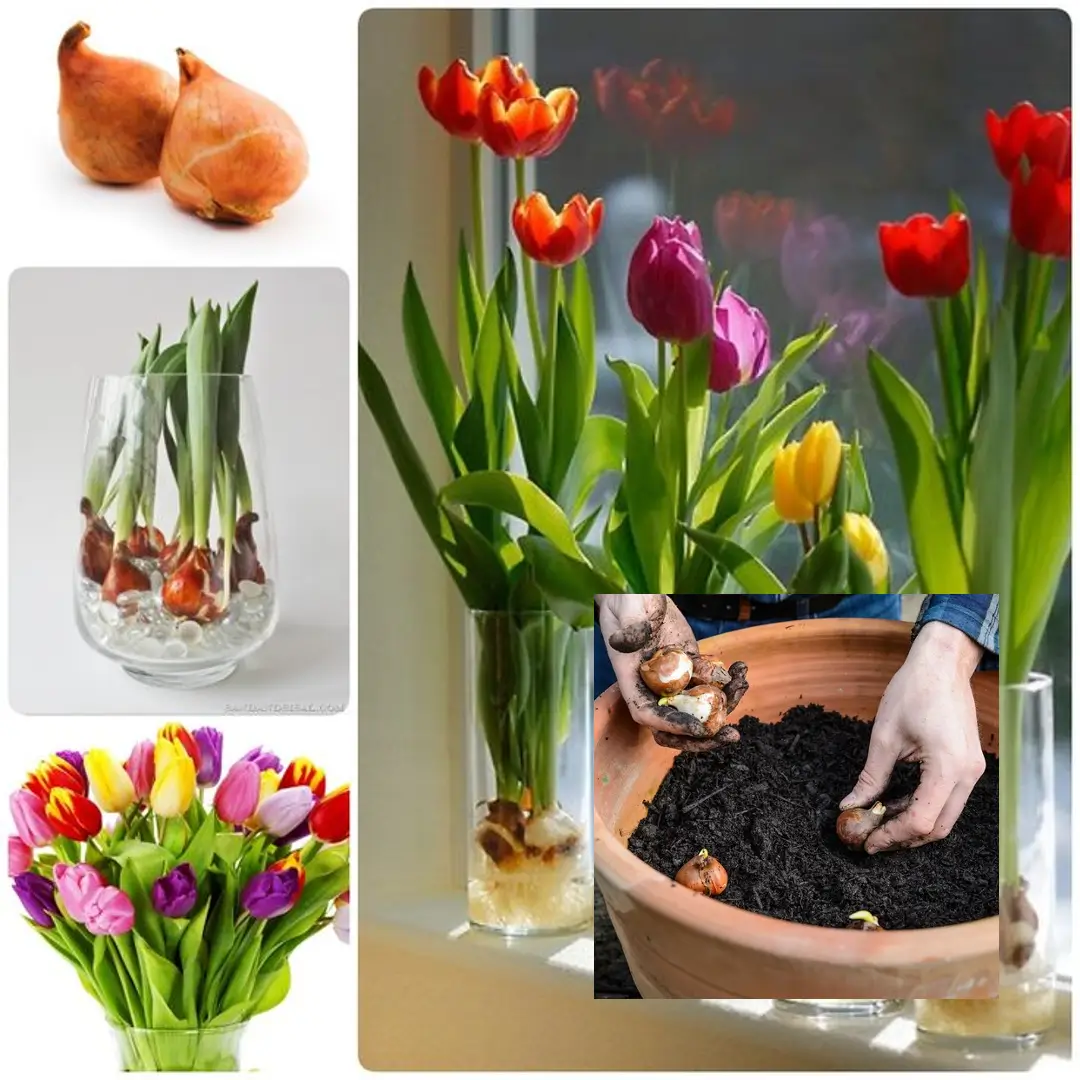Grow tulips and watch your garden come alive with vibrant colors when spring rolls around. Nothing brightens up the landscape quite like tulips, with their elegant shapes and dazzling hues. These showy bulbs are the crown jewels of any spring garden. But how do you grow tulips that will make your garden pop year after year? Well, you’re in the right place because I’m about to walk you through everything you need to know—from planting them at just the right time to solving those pesky garden problems that can pop up.
Growing tulips isn’t rocket science, but it does require a bit of know-how, planning, and a dash of patience to successfully grow tulips. Let’s dive in!
What Are Tulips?
Tulips are one of those classic spring flowers that you simply can’t miss. They come in nearly every color imaginable, from soft pastels to fiery reds and oranges. Whether you’re planting them in the garden or keeping them in pots on your patio, tulips add a burst of life just when you need it most—after a long, gray winter. So, let’s talk about how to get those tulips blooming to their full potential.
When to Plant Tulip Bulbs
Timing is everything when it comes to how to grow tulips! You want to get those bulbs in the ground in mid to late autumn. Ideally, November is the best time to plant tulip bulbs, but you can stretch it into December if you’re in a warmer part of the country. Forgot to plant by Christmas? No worries! You can still plant them as late as early January, and they’ll perform just fine. Think of it like this—planting tulips late is like sneaking in a quick workout before a big event. It’s better late than never, right?
Where Should You Plant Tulips?
If you want to grow tulips, remember that they are sun lovers, plain and simple. You’ll want to find a sunny, sheltered spot with moist but well-drained soil. If your soil is heavy clay or too sandy, don’t worry! You can easily improve it by adding well-rotted organic matter. Think of it as giving your tulips a spa day—you’re making the soil as comfy as possible for them to thrive. And if the soil is super heavy, sprinkle some horticultural grit at the bottom of the planting hole for extra drainage. Nobody likes soggy feet, including tulips!
How to Plant Tulips: The Perfect Depth
Now that you’ve found the ideal spot to grow tulips, it’s time to get planting! The rule of thumb here is to plant the bulbs at a depth of three times the height of the bulb. So, if your tulip bulb is about 5 cm tall, you’re going to plant it about 15 cm deep. Make sure the pointed end of the bulb is facing up—yes, bulbs have an “up” side! Space them about 5 cm apart from each other. This might sound like a bit of work, but trust me, your tulips will thank you with a stunning display come springtime.
Do You Need to Replant Tulips Every Year?
This is a question that often comes up, especially with how to grow tulips. Technically, tulips are perennials, meaning they should come back year after year. But, thanks to years of breeding for the most dazzling blooms, many tulip varieties only reliably flower for one season. For this reason, lots of gardeners plant fresh bulbs every autumn to make sure they get that jaw-dropping display every spring. If you’re growing tulips in pots, you’ll definitely want to plant new bulbs each year, as they tend to get tired after one season in a container.
Deadheading and Foliage Care for Tulips
Once your tulips have bloomed and had their moment in the spotlight, you’re not quite done. To make sure your bulbs store up enough energy to bloom again next year, you’ll want to deadhead them. This simply means snipping off the spent flowers so the plant doesn’t waste energy trying to produce seeds. However, don’t be too eager with those garden shears—wait until the foliage has turned yellow before you cut it back. This will usually happen about six weeks after flowering. Think of the leaves as solar panels—they’re collecting energy and feeding it back into the bulbs for next year’s display.
How to Propagate Tulips
If you want to grow even more tulips without buying new bulbs, you can propagate them! After your tulips have flowered and the foliage has died back, lift the bulbs from the soil with a garden fork. You’ll likely notice some small offset bulbs attached to the main bulb—these are baby bulbs! Gently pull them off, let them dry, and store them in a cool, dry place until autumn. When planting time rolls around again, you can plant these offsets alongside your larger bulbs. They’ll take a few years to reach full flowering size, but patience pays off!
How to Grow Tulips in Pots
Not enough space in the garden? No problem! If you want to grow tulips, they are just as happy growing in pots as they are in the ground. Start by filling your pot halfway with peat-free, multi-purpose compost, and plant the bulbs at the same depth as you would in the garden—three times the height of the bulb. Space them a bit closer together than you would in the ground because you want to create a big impact in a small space. Top off the pot with more compost and give them a good watering. One thing to remember—because the bulbs won’t be grown in the same pot next year, you can be a little more relaxed about planting them closely together.
The Best Tulip Varieties for Your Garden
There are so many types of tulips to choose from, it’s like picking out the perfect outfit for a special event. Do you want bold, statement-making tulips, or are you more into delicate, pastel shades? Early-flowering tulips bloom from late March to April, mid-season varieties flower from April to May, and late bloomers will show up in May. You can mix varieties to extend your blooming season or stick to a single type for a more uniform display. Either way, your garden is going to be a showstopper.
Common Issues When Growing Tulips
No garden is without its challenges, and if you want to grow tulips, you’ll face a few with these beautiful flowers. One of the biggest issues you might encounter is tulip fire—a fungal disease that causes unsightly brown spots and distorted growth. The good news is that you can reduce the risk of this disease by planting your bulbs after the first frost, which usually happens around November. Another potential problem? Squirrels! These little critters love digging up tulip bulbs for a snack. Protect your bulbs by covering the planting area with chicken wire or using other barriers.
How to Keep Tulips Coming Back Year After Year
While tulips don’t always reliably come back every year, there are a few things you can do to improve your chances. First, make sure you’re planting them in well-drained soil. Tulips hate soggy feet! Second, let the foliage die back completely before cutting it off—this helps the bulbs store up enough energy for the next year. If you’re really serious about getting your tulips to reflower, consider lifting the bulbs after the leaves have yellowed, drying them out, and replanting them in autumn.
Tulips Are Worth the Effort!
Growing tulips might take a bit of planning and care, but the reward is more than worth it. These stunning spring blooms are a true showstopper in any garden, and with a little bit of love and attention, you can enjoy them year after year. Whether you’re planting them in the ground or growing them in pots, knowing how to grow tulips gives you the chance to create a vibrant, colorful garden that bursts to life just when you need it most. So, get those bulbs in the ground, and let the magic of tulips take over your garden!
FAQs
Q1: What is the best month to plant tulips?
The best time to grow tulips by planting tulip bulbs is in November, when the ground has cooled and the first frost has usually hit. In milder climates, you can still plant them in December or even early January for a successful spring bloom.
Q2: Where do tulips grow best?
Grow tulips in sunny, well-drained locations for the best results. They thrive in soil that retains moisture but doesn’t become waterlogged. Tulips love full sunlight, so choose a spot where they can soak up at least 6 hours of sun a day.
Q3: Do tulips come back every year?
Tulips are technically perennials, but if you want to grow tulips that bloom reliably and give you a vibrant display, many varieties only flower well for one season. For the best results, it’s often recommended to plant new bulbs each year, especially in containers or if you’re aiming for a full, colorful garden.
Q4: How to grow tulips from seed?
Grow tulips from seed, but be prepared for a slow process that can take several years before you see a flowering plant. First, collect seeds from tulip seed pods after they’ve dried out. Sow the seeds in a container with well-draining soil and leave them in a cold, sheltered spot over the winter. Patience is key, as it can take 5-7 years for a mature tulip to bloom!


